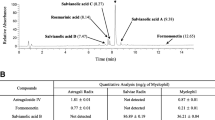Abstract
Consumption of certain product lots of l-tryptophan (LT) has been reported to be epidemiologically associated with an outbreak of eosinophilia-myalgia syndrome (EMS) in the United States. Since the production lots were found to contain 3-phenylamino alanine (PAA) as an impurity, its effects were studied by administering the substance orally by gavage to 5-week-old Sprague-Dawley rats. Groups of animals were given PAA for 13 consecutive weeks at dose levels of 1, 10 and 100 mg/kg per day. The animals were killed at 4 or 8 weeks. Hematological and blood biochemical tests were performed and detailed histopathological observations were made. No significant abnormalities were observed in the test animals and in particular no EMS-like conditions. A brief summary of other animal studies using several species of rats and mice performed in our laboratory since 1989 on various LT related substances is also presented. No EMS-like effects were observed in these studies.
Similar content being viewed by others
References
Anonymous (1989) Analysis of l-tryptophan for the etiology of eosinophilia-myalgia syndrome. MMWR 39: 789–790
Belongia EA, Hedberg CW, Gleich GJ, White KE, Mayeno AN, Loegering DA, Dunnette SL, Pirie PL, McDonald KL, Osterholm MT (1990) An investigation of the cause of the eosinophilia-myalgia syndrome associated with tryptophan use. N Engl J Med 323: 357–365
Bochner BS, Friedman B, Krishnaswami G, Schleimer RP, Lichtenstein LM, Kroegel C (1991) Episodic eosinophilia-myalgia-like syndrome in a patient without l-tryptophan use: association with eosinophil activation and increased serum levels of granulocyte-macrophage colony-stimulating factor. J Allergy Clin Immunol 88: 629
Clauw DJ, Scott L, Manz HJ, Kagan E, Katz P (1993a) A rat feeding study using tryptophan implicated as causal in the eosinophilia myalgia syndrome (EMS). Arth Rheum 35:[55]: S25 (abstract)
Clauw DJ, Blank C, Tefft M, Sears R, Moscowitz L, Marenco J, Katz P, Manz H (1993b) Features of the eosinophilia myalgia syndrome (EMS) in a mouse model. Arth Rheum 36: [95] S 114 (abstract)
Clauw DJ, Ward K, Wilson B, Katz P, Rajan S (1994) Magnesium deficiency in the eosinophilia-myalgia syndrome. Report of clinical and biochemical improvement with repletion. Arth Rheum 37: 1331–1334
Duffy J, Engel AG, Bowles C (1991) Eosinophilia-myalgia syndrome: not associated with l-tryptophan. Arth Rheum 34: S132 (abstract)
Goda Y, Suzuki J, Maitani T, Yoshihira K, Takeda M, Uchiyama M (1992) 3-anilino-l-alanine, structural determination of UV-5, a contaminant in EMS-associated l-tryptophan samples. Chem Pharm Bull 40: 2236–2238
Herrick MK, Chang Y, Horoupian DS, Lombard CH, Adornato BT (1991) l-Tryptophan and the eosinophilia-myalgia syndrome: Pathologic findings in eight patients. Hum Pathol 22: 12–21
Hertzman PA, Blevins WL, Mayer J, Greenfield B, Ting M, Gleich GJ (1990) Association of the eosinophilia-myalgia syndrome with the ingestion of tryptophan. N Engl J Med 322: 869–873
Hertzman P, Clauw D, Kaufman L, Silver R, Varga J, Callahan L, Pincus T (1993) 18–24 Month structured follow-up of 210 patients with eosinophilia-myalgia syndrome (EMS) in 12 States. Arth Rheum 36: R26 (abstract)
Hibbs JR, Mittleman B, Hill P, Medsger TA (1992) l-Tryptophan-associated eosinophilic fasciitis prior to the 1989 eosinophilia-myalgia syndrome outbreak. Arth Rheum 35: 299–303
Ito J, Hosaki Y, Torigoe Y, Sakimoto K (1992) Identification of substances formed by decomposition of peak E substance in tryptophan. Food Chem Toxicol 30: 71–81
Love LA, Rader JI, Crofford LJ, Raybourne RB, Principato MA, Page SW, Trucksess MW, Smith MJ, Dugan EM, Tumer ML, Zelazowski E, Zelazowski P, Sternberg EM (1993) Pathological and immunological effects of ingesting l-tryptophan and 1,1′-ethylidenebis (l-tryptophan) in Lewis rats. J Clin Invest 91: 804–811
Mayeno AN, Lin F, Foote CS, Loegering DA, Ames MM, Hedberg CW, Gleich GJ (1990) Characterization of “Peak E”, a novel amino acid associated with eosinophilia-myalgia syndrome. Science 250: 1707–1708
Mayeno AN, Belongia EA, Lin F, Lundy SK, Gleich GJ (1992) 3(Phenylamino) alanine, a novel aniline-derived amino acid associated with the eosinophilia-myalgia syndrome: a link to the toxic oil syndrome? Mayo Clin Proc 67: 1134–1139
Patmas MA (1992) Eosinophilia myalgia syndrome not associated with l-tryptophan. J Med Soc NJ 89: 285
Philen RM, Eidson MA, Kilbourne EM, Sewell CM, Voorhees R (1991) Eosinophilia-myalgia syndrome — a clinical case series of 21 patients. Arch Int Med 151: 533–537
Philen RM, Hill RH, Flanders WD, Caudill SP, Needham L, Sewell L, Sampson EJ, Falk H, Kilbourne EM (1993) The eosinophilia-myalgia studies of Oregon, New York, and New Mexico. Am J Epidemiol 138: 154–159
Silver RM, Ludwicka A, Hampton M, Ohba T, Bingel SA, Smith T, Harley RA, Maize J, Heyes MP (1994) A murine model of the eosinophilia myalgia syndrome induced by 1,1′-ethylidenebis (tryptophan). J Clin Invest 93: 1473–1480
Spitzer WO, Haggerty J, Tamblyn E, Berkson L, Elmore J, Horwitz RI (1994) Continuing occurrence of eosinophilia myalgia syndrome. Clin Res 42: 292A (abstract)
Swygert LA, Maes EF, Sewell LE, Miller L, Falk H, Kilbourne EM (1990) Eosinophilia-myalgia syndrome: results of nationwide surveillance. JAMA 264: 1698–1703
Tazelaar HD, Myers JL, Strickler JG, Colby TV, Duffy J (1993) Tryptophan-induced lung disease: an immunophenotypic, immunofluorescent, and electron microscopic study. Mod Pathol 6: 56–60
Author information
Authors and Affiliations
Rights and permissions
About this article
Cite this article
Sato, F., Hagiwara, Y. & Kawase, Y. Subchronic toxicity of 3-phenylamino alanine, an impurity in l-tryptophan reported to be associated with eosinophilia-myalgia syndrome. Arch Toxicol 69, 444–449 (1995). https://doi.org/10.1007/s002040050197
Received:
Accepted:
Issue Date:
DOI: https://doi.org/10.1007/s002040050197



